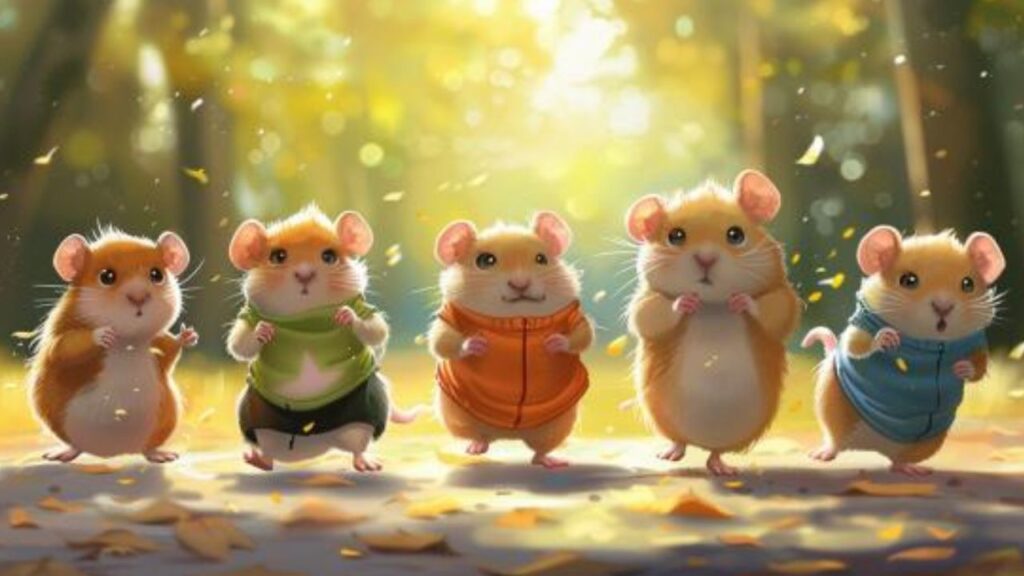Welcome to the bustling world of hamster training, where the challenge of juggling multiple furry personalities can turn into a symphony of success with the right approach. Training multiple hamsters isn’t just about doubling your treats and tripling your patience; it’s an art form that, when done correctly, offers a plethora of benefits not only for the hamsters but for you, the trainer, as well. Imagine orchestrating a tiny, fluffy ballet where each performer learns not just to dance on their own but in harmony with their peers. That’s the magic we’re aiming for in group hamster sessions.
However, with great fluff comes great responsibility. Training multiple hamsters introduces a unique set of challenges, from navigating their individual personalities to managing the dynamics of their interactions. Hamsters, by nature, are solitary animals, and their inclination to establish territory can lead to some hairy (pun intended) situations when brought together. Yet, when carefully managed, group training sessions can foster social skills, reduce anxiety through companionship, and even enhance learning through observation, making the endeavor not just possible but profoundly rewarding.
Understanding hamster behavior in group settings is crucial. Each hamster is a universe unto themselves, with distinct likes, dislikes, and even quirks. Observing how they interact with one another, who’s the brave explorer and who’s the cautious observer, allows us to tailor training sessions that respect their individuality while leveraging their collective energy. It’s about finding that sweet spot where each hamster feels seen and supported, paving the way for a group dynamic that’s more harmonious than a choir of singing hamsters.
In the following sections, we’ll dive deep into the dynamics of hamster groups, share tips for setting up successful sessions, and unveil the art of group training. Whether you’re a seasoned hamster trainer or just starting, understanding these fundamentals will equip you with the knowledge to transform your training sessions from chaotic to charismatic, ensuring your little furballs are not just learning but thriving together.
Understanding the Dynamics of Hamster Groups

When we talk about training multiple hamsters, it’s crucial to start by understanding the natural tapestry of hamster social structures and behaviors. This knowledge acts as our roadmap, guiding us through the intricacies of their world and helping us navigate the group training sessions with insight and empathy.
Natural Hamster Social Structures and Behaviors
Contrary to the bustling community life of other rodents, hamsters are known for their love of solitude. In the wild, they’re solitary creatures, carving out their own little kingdoms under the cover of night. This preference for solitude is rooted deep in their survival instincts, where food competition and predator avoidance are daily concerns. As such, their social structure is, well, a bit of an oxymoron—it doesn’t really exist in the way we see with other animals. Instead, interactions are often limited to mating or occasional territorial disputes.
In the cozy confines of our homes, however, we see a different side of these creatures. While they still carry their ancestral torch of independence, they can learn to tolerate, and sometimes even enjoy, the company of their kind under the right circumstances. This delicate balance is something to be mindful of when orchestrating group training sessions. Recognizing signs of stress or aggression early on can prevent disputes and ensure a safe, positive learning environment for all involved.
How These Dynamics Affect Training Sessions
The solitary nature of hamsters means that training multiple hamsters together isn’t as straightforward as one might hope. It requires a nuanced approach, blending understanding with patience. Recognizing individual boundaries and personal space is key. For instance, while some hamsters might be more open to shared activities, others may need a gentle nudge in the form of positive reinforcement to feel comfortable in a group setting.
This dynamic affects training sessions in several ways. Firstly, it emphasizes the importance of individualized attention. Just because they’re in a group doesn’t mean they lose their individuality. Some may learn tricks faster than others, and some may prefer different types of rewards. It’s a balancing act, ensuring each hamster feels seen and valued.
Secondly, it challenges us to create a training environment that respects their natural inclinations for solitude while encouraging social interaction. This might mean designing activities that allow for both communal engagement and solo adventures, ensuring that each hamster can participate in a way that feels safe and natural to them.
Understanding the dynamics of hamster groups is not just about managing potential conflicts; it’s about creating a space where learning can happen in harmony. It’s recognizing that, while they may naturally prefer their own company, with the right approach and a dash of creativity, hamsters can enjoy and benefit from the shared experience of group training sessions. By respecting their natural behaviors and adapting our training methods accordingly, we’re not just teaching them tricks; we’re teaching them the art of companionship.
Setting Up for Success

Embarking on the journey of training multiple hamsters requires a foundation built on safety, stimulation, and a sprinkle of creativity. The environment in which these furry athletes learn and play plays a pivotal role in their training success. Let’s explore how to craft a setting that caters not just to their physical needs but to their curious minds as well, ensuring each hamster can shine in the group spotlight.
Tips for Creating a Safe and Stimulating Environment for Multiple Hamsters
Creating a haven that is both safe and engaging for multiple hamsters involves thoughtful consideration of their natural instincts and preferences. Here’s how to turn your training space into a hamster utopia:
- Space Odyssey: First and foremost, ensure there’s ample room for all. Hamsters value their personal bubble, and a cramped space can lead to stress and squabbles. A larger area allows them to explore, play, and engage without stepping on each other’s tails—literally.
- Zone Management: Divide the training area into zones—resting areas, play sections, and training grounds. This not only helps in keeping activities organized but also allows hamsters to take breaks and have time out when needed, reducing stress and promoting a positive training experience.
- Hideaways and Highways: Incorporate tunnels, hideouts, and climbing structures. These elements mimic their natural environment, encouraging exploration and exercise. Plus, they can serve as interactive training tools, making learning fun and engaging.
- Safety First: Ensure the environment is escape-proof and free from potential hazards. Regularly check for any small spaces or dangerous objects that curious hamsters might squeeze into or chew on. Remember, a safe hamster is a happy hamster.
- Sensory Stimulation: Use a variety of textures, materials, and toys to stimulate their senses. This not only keeps them engaged but can also be used to enhance training sessions, making tasks more appealing and rewarding.
Importance of Individual Attention Within the Group
While the physical environment is crucial, the emotional and psychological atmosphere is equally significant. Each hamster, with its unique personality, requires individual attention to truly thrive in a group setting:
- Personalized Approach: Tailor your interactions and training methods to suit each hamster’s temperament and learning pace. Recognizing their individual needs and preferences fosters a deeper bond and enhances their learning potential.
- Spotlight Moments: Allocate time for one-on-one sessions within the group context. This not only helps in addressing specific training challenges but also assures each hamster of its value in your eyes, boosting confidence and cooperation.
- Observational Learning: Encourage hamsters to learn from watching their peers, a phenomenon known as social learning. This can be especially effective in group settings, where seeing a fellow hamster succeed can inspire others to try new tasks.
- Emotional Check-ins: Pay close attention to signs of stress or discomfort. Individual attention means noticing when a hamster might need a break from the group or a different approach to learning. Respecting these signals is key to maintaining a positive and productive training environment.
Setting up for success in training multiple hamsters is about balancing the group’s collective energy with the individual needs of each member. By creating a space that is both physically stimulating and emotionally supportive, you lay the groundwork for a training experience that is as enriching as it is enjoyable. Remember, the goal is not just to teach tricks but to nurture happy, healthy hamsters who feel confident and connected, both with you and with their furry friends.
The Art of Group Hamster Training

Mastering the art of group hamster training is akin to conducting an orchestra—each little musician has a part to play, and harmony is achieved not by uniformity but through the celebration of individual strengths and contributions. Let’s delve into the techniques and strategies that can help maintain attention and motivation among your hamster ensemble, ensuring that each session is a step toward a collective masterpiece.
Techniques for Maintaining Attention and Motivation Among Multiple Hamsters
Keeping a group of hamsters engaged and motivated requires a blend of creativity, patience, and a bit of psychological savvy. Here are some techniques to help you keep their tiny eyes on the prize:
- Rotating Spotlight: Implement a system where each hamster gets a turn in the spotlight, ensuring they all receive equal opportunities to engage in tasks and receive rewards. This not only helps in maintaining individual motivation but also keeps the group’s attention as they anticipate their turn.
- Interactive Games: Design activities that require cooperation or mild competition, encouraging hamsters to be active participants. Simple relay races or synchronized tasks can make training fun and engaging, tapping into their natural curiosities.
- Varied Rewards: Hamsters, like humans, have their own preferences. Use a variety of treats and rewards to keep them guessing and engaged. Understanding what makes each hamster tick can be the key to unlocking their full potential.
- Short and Sweet: Keep training sessions brief but frequent. Hamsters have short attention spans, so shorter sessions ensure they stay engaged without becoming overwhelmed or bored. This approach also allows for more frequent positive reinforcement, which is crucial for learning.
Strategies for Addressing Individual Needs While Fostering Group Harmony
Creating a cohesive group dynamic without neglecting the individual needs of each hamster is a delicate balancing act. Here are strategies to ensure that your training sessions are inclusive and harmonious:
- Individual Assessments: Regularly assess each hamster’s progress and adapt training methods accordingly. This personalized attention ensures that no hamster feels left behind, promoting a sense of belonging and harmony within the group.
- Group Bonding Activities: Incorporate activities that strengthen social bonds between the hamsters. Shared exploration or playtime outside of structured training sessions can enhance group cohesion and reduce potential friction.
- Conflict Resolution: Be vigilant for signs of tension or conflict and intervene early with positive distraction techniques. Redirecting focus to a neutral activity can prevent escalations and maintain a peaceful training environment.
- Celebrate Group Achievements: Acknowledge and celebrate milestones achieved by the group as a whole. This fosters a sense of collective achievement and encourages hamsters to see the value in working together.
The art of group hamster training is not just about teaching tricks; it’s about weaving a tapestry of individual achievements into a collective success story. By employing these techniques and strategies, you’re not only guiding your hamsters toward new skills but also nurturing a social environment where every member feels valued and understood. This approach ensures that your training sessions are more than just educational—they’re a journey toward mutual respect and understanding, paving the way for a harmonious and enriching group dynamic.
Behavioral Synchronization

In the realm of group hamster training, achieving a state of “Hamster Harmony” is the pinnacle of success. This concept goes beyond mere cooperation, aiming for a level of behavioral synchronization where each hamster’s actions not only align with the training goals but also with each other, creating a seamless flow of furry finesse. Let’s explore how we can introduce and cultivate this concept in our training sessions, ensuring that our little companions not only thrive individually but also excel as a cohesive unit.
Introducing the Concept of “Hamster Harmony” in Training Sessions
“Hamster Harmony” is not just about getting your hamsters to perform tasks together; it’s about fostering an environment where they feel in tune with each other’s presence and energies. This synergy allows for a more dynamic and responsive training experience, where hamsters learn from and are motivated by each other. Here’s how to plant the seeds of harmony in your sessions:
- Shared Experiences: Begin with activities that hamsters can enjoy together, such as exploring a new toy or navigating a simple maze. These shared experiences serve as ice breakers, reducing tension and building a foundation of mutual interest and curiosity.
- Synchronized Routines: Gradually introduce training exercises that require synchronized actions, such as moving in the same direction or performing a simple task simultaneously. This not only enhances their ability to work as a team but also strengthens their individual learning through repetition and observation.
- Emotional Tuning: Pay attention to the group’s emotional climate. Encourage positive interactions and reward collective good behavior. This emotional tuning helps reinforce the idea that they are part of a supportive and rewarding community.
Practical Steps to Achieve Behavioral Synchronization Among Hamsters
Creating a synchronized squad of hamsters involves patience, observation, and a bit of creativity. Here are practical steps to guide your hamsters towards achieving behavioral synchronization:
- Step-by-Step Guidance: Start with very basic synchronized actions and gradually increase complexity as the group becomes more comfortable and proficient. This step-by-step approach ensures that all hamsters are on the same page, reducing frustration and fostering a sense of accomplishment.
- Consistent Cues: Use consistent cues (visual, auditory, or a combination of both) to signal the start and end of synchronized activities. These cues help hamsters associate specific actions with being part of a group activity, making it easier for them to understand and anticipate what is expected of them.
- Reward Synchronization: Implement a reward system that not only acknowledges individual effort but also rewards the group’s collective success. This could mean offering treats to all participants when a group task is successfully completed, reinforcing the value of working together.
- Monitor and Adjust: Keep a close eye on how each hamster is adapting to the group dynamics. Be ready to adjust training methods or group compositions if certain pairings or activities are not yielding the desired harmony. Flexibility is key in finding the perfect balance that works for your unique ensemble.
Achieving behavioral synchronization, or “Hamster Harmony,” is a journey that requires understanding, patience, and a willingness to adapt. By following these practical steps, you can guide your hamsters towards a state of synchronized behavior where each individual contributes to a harmonious and dynamic group performance. This not only enhances their training experience but also enriches their social interactions, making each session a step towards a more cohesive and understanding hamster community.
Challenges and Solutions in Multi-Hamster Training

Training multiple hamsters simultaneously can sometimes feel like trying to herd a group of fluffy, energetic clouds—each with its own direction and pace. While the rewards of achieving group harmony are vast, the path is sprinkled with obstacles that require patience, ingenuity, and a deep understanding of hamster psychology to overcome. Let’s navigate through some common challenges faced during group training sessions and explore solutions that can lead to successful outcomes.
Common Obstacles Faced During Group Training Sessions and How to Overcome Them
Obstacle 1: Dominance and Territorial Behavior
Hamsters, by nature, can exhibit dominance or territorial behavior, especially in a group setting, leading to potential conflicts.
- Solution: Establish clear boundaries and personal spaces for each hamster within the training area. Introduce group members gradually, allowing them to become accustomed to each other’s scent and presence in a controlled, neutral environment. Use distractions and positive reinforcement to redirect negative behaviors towards more desirable outcomes.
Obstacle 2: Varying Learning Paces
Each hamster has its own pace of learning, which can result in disparities in group progress.
- Solution: Tailor training sessions to cater to different learning speeds. Incorporate activities that allow for individual progress within a group framework, ensuring no hamster feels left behind. Celebrate small victories to keep motivation high for slower learners.
Obstacle 3: Maintaining Attention
Keeping a group of hamsters focused can be challenging, given their short attention spans and individual interests.
- Solution: Keep training sessions short and engaging. Use a variety of training methods and stimuli to cater to different preferences, keeping the sessions dynamic and interesting for all participants. Regular breaks can also help manage energy levels and maintain focus.
Case Studies and Anecdotal Evidence Highlighting Successful Strategies
Case Study: The Harmony Project
A group of five hamsters was introduced to a series of synchronized activities, including a shared feeding puzzle that required cooperative effort to solve. Initial sessions were marked by confusion and mild competition. However, through consistent cues and the introduction of joint rewards, the group began to exhibit signs of cooperation, eventually working together seamlessly to achieve their goal. This case highlights the importance of patience and the use of shared goals to foster group cohesion.
Anecdotal Evidence: Timmy and the Tunnel Challenge
In an informal setting, a trainer introduced a tunnel maze to a group of hamsters with varied success in individual training sessions. Initially, each hamster approached the maze independently, with varying degrees of enthusiasm and success. The trainer then implemented a buddy system, pairing more confident hamsters with less confident ones and rewarding them for mutual progress. This strategy not only improved overall maze completion times but also seemed to boost the confidence of the less adept hamsters, demonstrating the power of peer influence and support in overcoming training hurdles.
Overcoming the challenges in multi-hamster training requires a blend of creativity, flexibility, and a deep understanding of hamster behavior. By acknowledging individual needs within the group context and employing strategies that promote cooperation and mutual respect, trainers can navigate these obstacles successfully. The journey may be dotted with trials, but the destination—a harmonious and synchronized group of hamsters—is well worth the effort.
Hannah’s Training Tactics

Welcome to the grand finale of our group hamster training symphony, where I share my secret sauce—quick, actionable tips that you can sprinkle over your training sessions for that extra zing of success. These tactics are the culmination of years of trial, error, and triumphs in the fluffy arena of hamster training. Whether you’re a novice trainer facing the challenge of a hamster quartet for the first time or a seasoned whisperer looking to fine-tune your group sessions, these tips are your golden nuggets of wisdom.
Quick, Actionable Tips for Immediate Implementation in Group Hamster Training Sessions
- The Name Game: Start each session by calling each hamster by name with a treat in hand. This not only aids in individual recognition but also establishes a positive association with training sessions.
- Micro-Session Magic: Break down training sessions into micro-sessions, focusing on one specific skill or activity at a time. This keeps the hamsters engaged and prevents overwhelm.
- Treat Variety Show: Rotate through a variety of treats to maintain interest and motivation. Discover each hamster’s favorite and use it to reward especially good performance or cooperation.
- Spotlight Rotation: Ensure each hamster gets its moment in the spotlight. Individual attention within the group setting boosts confidence and reinforces desired behaviors.
- Buddy System: Pair hamsters with complementary temperaments for certain activities. This can help shy hamsters come out of their shells and provides natural role models in the group.
- Success Celebration: Celebrate successes, no matter how small, with a group cheer or a collective treat. This fosters a sense of team spirit and shared achievement.
- Patience Pause: If tensions rise or focus wanes, implement a “patience pause,” a brief period where hamsters can relax and reset before continuing with the session.
Encouragement for Patience and Consistency in Training
Embarking on the journey of group hamster training is akin to planting a garden. It requires patience, consistency, and a whole lot of love. Some days, it might feel like your efforts are in vain, as if your tiny students are more interested in anything but the task at hand. Yet, with each session, you’re laying the groundwork for growth, trust, and understanding.
Remember, every hamster progresses at its own pace, and setbacks are just stepping stones to success. Celebrate the small victories, learn from the challenges, and keep a steady course. Consistency is key—not just in the routine but in your approach and reactions. Your little learners are watching and learning from you at every moment.
In the grand scheme of things, the goal of training is not just about mastering tricks or obedience; it’s about building a bond of trust, respect, and mutual understanding with your hamsters. It’s about creating a shared language that transcends words, where every click, treat, and gentle nudge is a conversation.
So, take a deep breath, arm yourself with treats and patience, and step into each training session with a heart full of optimism. The journey of group hamster training is a marathon, not a sprint, and every step forward is a cause for celebration.
Conclusion

As we draw the curtains on our comprehensive journey through the nuances of training multiple hamsters in group sessions, it’s important to reflect on the harmony and chaos, the challenges and triumphs that come with this unique endeavor. Training multiple hamsters isn’t just a task; it’s an adventure that unfolds with each interaction, revealing the depth of their personalities and the strength of their potential when nurtured in a supportive, group environment.
Recap the Benefits of Training Multiple Hamsters in Group Sessions
Group training sessions offer a plethora of benefits that extend beyond the simple acquisition of skills. They foster a sense of community among the hamsters, teaching them valuable lessons in socialization, patience, and even empathy. These sessions are not just about learning tricks; they’re about creating a harmonious environment where each hamster can grow, not only in confidence but in their ability to interact with their peers and human companions. The joy of watching hamsters learn from and motivate each other is unmatched, providing a rewarding experience for both the trainer and the trainees.
Reinforce the Importance of Understanding Hamster Behavior and Individuality
At the heart of successful group hamster training lies a deep understanding of hamster behavior and individuality. Recognizing the unique temperament, preferences, and learning pace of each hamster is crucial in creating a training program that respects their natural instincts while encouraging them to embrace the benefits of group dynamics. This tailored approach ensures that each hamster feels seen and valued, fostering a positive learning environment that celebrates individual achievements within the framework of group harmony.
Training multiple hamsters in group sessions is a delicate balance of science and art, requiring a fusion of behavioral knowledge, patience, and creativity. It’s about recognizing the individual light within each hamster and finding ways to let them shine together, creating a constellation of learning and growth. As we embark on this journey, let’s remember the power of patience, the importance of understanding, and the joy of seeing our furry friends thrive in each other’s company.
With paws and patience, you’re on the road to being a Hamster Whisperer. Happy training!




